JRE has set environment-related KPIs including CO2 reduction targets for FY2030.
To reach our FY2030 goals we will carry out various initiatives with the cooperation of internal and external partners.

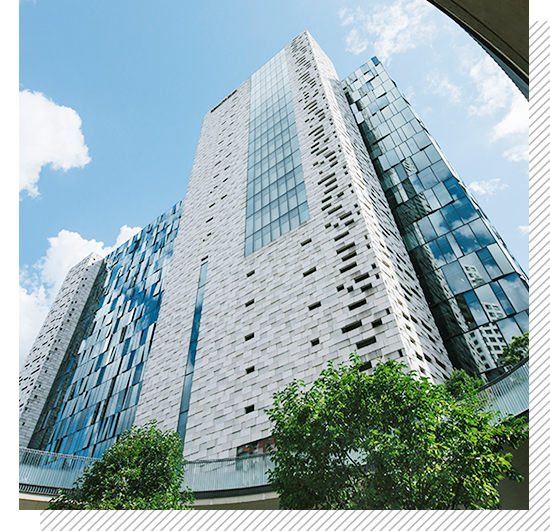
Environmental Performance
Based on the Sustainability Policy items “1. Climate change initiative (promoting decarbonization and strengthening resilience)” and
“2. Contribution to resource conservation including water and resource recycling”, JRE has set reduction targets for energy consumption and greenhouse gas emissions in order to improve the environmental performance of its real estate portfolio.
In order to achieve these targets, JRE’s asset management company, JRE-AM implements measures to improve the operational performance of buildings, conduct energy efficiency retrofits, and engage tenant on energy efficiency based on its “Energy Conservation Policy”, which stipulates operational policies for improving energy efficiency of the real estate portfolio, and “GHG Emissions Reduction Policy”, which aims to create a decarbonized society.
CO2 Emissions Reduction Targets and KPIs for FY2030
In response to the growing concerns over the risks from climate change, JRE recognizes that reduction of greenhouse gas (GHG) emissions is of critical importance in light of enhancing the sustainability of our future business. We have been working to reduce energy consumption and GHG emissions of its portfolio, and has achieved a lower consumption and emissions than the previous levels. We verified the possibility of reducing CO2 emissions from over 70 of our properties and established reduction targets for FY2030. Going forward, JRE will contribute to a shift to a decarbonized society through the reduction of GHG emissions while securing its preparedness to natural disasters and other phenomena arising from climate change.
■Related information: Climate Change Initiative
Environmental Performance Data
Key Performance Indicator (KPI)
Achieve 80% reduction in CO2 emissions by FY2030 compared with the FY2019 level.
Achieve 12kg-CO2/m² or below of CO2 emissions intensity by FY2030.
* Please view the table below while scrolling horizontally.
| FY 2019 (Base year) |
FY 2022 | FY 2023 | FY 2024 | % change (vs FY2019) |
|||||
|---|---|---|---|---|---|---|---|---|---|
| Total CO2 emissions |
Total | t-CO2 | 102,942 | 31,038 | 25,518 | 24,158 | -76.53% | ||
| Scope1 (Fuels) | t-CO2 | 3,208 | 2,785 | 2,659 | 2,627 | -18.12% | |||
| Scope2 (Electricity, District Heating & Cooling) (Market-based method) | t-CO2 | 42,436 | 16,046 | 13,251 | 12,734 | -69.99% | |||
| Scope3 (Fuels, Electricity and District Heating & Cooling that occur in tenant controlled areas) Category#13:Downstream Leased Assets |
t-CO2 | 57,297 | 12,207 | 9,607 | 8,797 | -84.65% | |||
| Intensity (Scope1 + Scope2 + Scope3) | kg-CO2/m² | 77.7 | 23.1 | 19.1 | 18.0 | -76.88% | |||
| Total | Total (Scope1 + Scope2 + Scope3) | MWh | 246,064 | 228,073 | 239,395 | 240,704 | -2.18% | ||
| Intensity (Scope1 + Scope2 + Scope3) | MWh/m² | 0.186 | 0.170 | 0.179 | 0.179 | -3.64% | |||
| Fuel consumption | Total (Scope1 + Scope3) | MWh | 22,466 | 19,719 | 18,404 | 18,489 | -17.70% | ||
| Intensity (Scope1 + Scope3) | MWh/m² | 0.017 | 0.015 | 0.014 | 0.014 | -18.93% | |||
| Other heat consumption※1 |
Total (Scope2 + Scope3) | MWh | 30,436 | 32,860 | 35,393 | 36,829 | 21.00% | ||
| Intensity (Scope2 + Scope3) | MWh/m² | 0.023 | 0.024 | 0.026 | 0.027 | 19.20% | |||
| Electricity consumption | Total (Scope2 + Scope3) | MWh | 193,162 | 175,494 | 185,599 | 185,386 | -4.03% | ||
| Intensity (Scope2 + Scope3) | MWh/m² | 0.146 | 0.130 | 0.139 | 0.138 | -5.46% | |||
| Intensity (Scope2 | MWh | 79,728 | 76,125 | 79,210 | 79,147 | -0.73% | |||
| Intensity (Scope3 | MWh | 113,434 | 99,369 | 106,389 | 106,239 | -6.34% | |||
Amount purchased from a District Heating and Cooling (DHC) system provider
Key Performance Indicator (KPI)
Achieve 85% Renewable Energy (Scope2) Rate by FY2025 / 90% by FY2030 / 100% by FY2050.
* Please view the table below while scrolling horizontally.
| FY 2019 | FY 2022 | FY 2023 | FY 2024 | ||||
|---|---|---|---|---|---|---|---|
|
Renewable Energy Rate (Scope2)*2 |
% | 1.6% | 70.9% | 79.7% | 82.2% | ||
| <Reference> Renewable Energy Rate (Scope2 & Scope3)*2 |
% | 1.6% | 73.2% | 81.6% | 84.2% | ||
Electricity of each scope is calculated.
Key Performance Indicator (KPI)
Achieve 20% reduction in Water Consumption (intensity) by FY2030 compared with the FY2019 level.
* Please view the table below while scrolling horizontally.
| FY 2019 (Base year) |
FY 2022 |
FY 2023 | FY 2024 | % change (vs FY2019) |
|||
|---|---|---|---|---|---|---|---|
| Water Consumption | Total | m³ | 886,256 | 698,002 | 779,941 | 801,545 | -9.56% |
| Intensity | m³/m² | 0.669 | 0.519 | 0.583 | 0.596 | -10.91% |
Key Performance Indicator (KPI)
Achieve more than 90% Waste Recycling Rate by FY2030.
* Please view the table below while scrolling horizontally.
| FY 2019 (Base year) |
FY 2022 | FY 2023 | FY 2024 | ||||
|---|---|---|---|---|---|---|---|
| Waste | Total waste | t | 8,095 | 5,846 | 6,387 | 6,416 | |
| Recycling | t | 4,540 | 3,255 | 3,539 | 3,617 | ||
| Recycling rate*3 | % | 56.1 | 55.7 | 55.4 | 56.4 |
Recycling / Total waste
* Please view the table below while scrolling horizontally.
| FY 2019 (Base year) |
FY 2022 |
FY 2023 | FY 2024 | ||||
|---|---|---|---|---|---|---|---|
| Data coverage | CO2 emissions and energy amount | 100% | 100% | 100% | 100% | ||
| Water consumption | 100% | 100% | 100% | 100% | |||
| Waste generated | 100% | 100% | 100% | 100% | |||
- The above data may differ from previously disclosed data due to a re-examination of the data.
- As a general rule, all properties owned as of the end of each fiscal year are covered.
WEB information
- The above data is subject to limited assurance by a third-party organization (Ernst & Yong ShinNihon LLC) based on the International Standard for Assurance Engagements Other Than Audits or Reviews of Historical Financial Information (`ISAE 3000 (Revised)') and with respect to GHG emissions, the International Standard on Assurance Engagements: Assurance Engagements on Greenhouse Gas Statements (`ISAE 3410'), issued by the International Auditing and Assurance Standards Board. For detailed calculation criteria, please refer to “Environmental Performance Data/Supplementary Items” and “CO2 Emission Coefficient of Each Power Supplier”.
The Tokyo Metropolitan Government’s Ordinance on the Environment to Ensure the Health and Safety of Tokyo Residents (Tokyo Environmental Security Ordinance)
Global Warming Countermeasure Reporting Program
The global warming countermeasure reporting program applies to business operators who own or use small and medium-sized business establishments in Tokyo (business establishments with an annual fuel, heat, and electricity consumption equivalent to at least 30 kL and less than 1,500 kL of crude oil in the previous fiscal year) where the combined annual energy consumption at all of their small and medium-sized business establishments is equivalent to 3,000 kL or more of crude oil in the previous fiscal year. Business operators subject to this program have a duty to report, to the Tokyo Metropolitan Government, on their CO2 emissions and the implementation status of global warming countermeasures at each of their business establishments.
In accordance with this program, JRE has submitted global warming countermeasure reports. Information from the reports is available on the Tokyo Metropolitan Government Bureau of the Environment’s website. (available only in Japanese)
In FY2024, JRE was certified as an outstanding global warming countermeasures business operator (FY2024 “S” rank) by the Tokyo Metropolitan Government Bureau of the Environment in recognition of its global warming countermeasure efforts.
Read more about countermeasures at small and medium-sized business establishments in Tokyo here. (available only in Japanese)


Mandatory CO2 Reduction and Emissions Trading Program (The Tokyo Cap-and-Trade Program)
The Cap-and-Trade Program mandates that large business establishments in Tokyo (those with an annual fuel, heat, and electricity consumption equivalent to 1,500 kL or more of crude oil in the previous fiscal year) reduce their CO2 emissions. View a list of JRE properties subject to the program here.
Read more about countermeasures at large business establishments in Tokyo here
- Tokyo Metropolitan Government English website
- Tokyo Metropolitan Government Bureau of the Environment’s website (available only in Japanese)
Environmental Management Systems (EMS)
Grasping Accurate Data and Executing a PDCA Cycle
JRE measures and gains an understanding of the energy consumption, water consumption, waste volume of each building and recycling rate on a monthly basis. We outsource data calculation and data analysis to a company specializing in EMS to execute its PDCA cycle. If there is a large difference in the aggregated data from the previous month or year, we investigate the cause by conducting interviews with the property manager and ensuring accurate data. We also constantly monitor the reduction effects of green refurbishments such as LED and AC upgrades.
Aggregated data disclosed in “WEB information” has been given limited assurance in accordance with ISAE 3000 and ISAE 3410 (International Standard on Assurance Engagements) by a third party organization.
■Related Information: Environmental Performance
Monthly Data Entry, Analysis, and Feedback
JRE-AM recognizes environmental data aggregated via EMS as important indicator, as well as performance data. Therefore, the data and a analysis of the various indicators are reported to the Chief Sustainability Officer (President & CEO) on a monthly basis. This is not a matter of simply circulating documents. Instead, these indicators are reported and analyzed at meeting and are an important part of decision-making for future asset management and CAPEX investments.
PDCA Cycle for Environmental Data
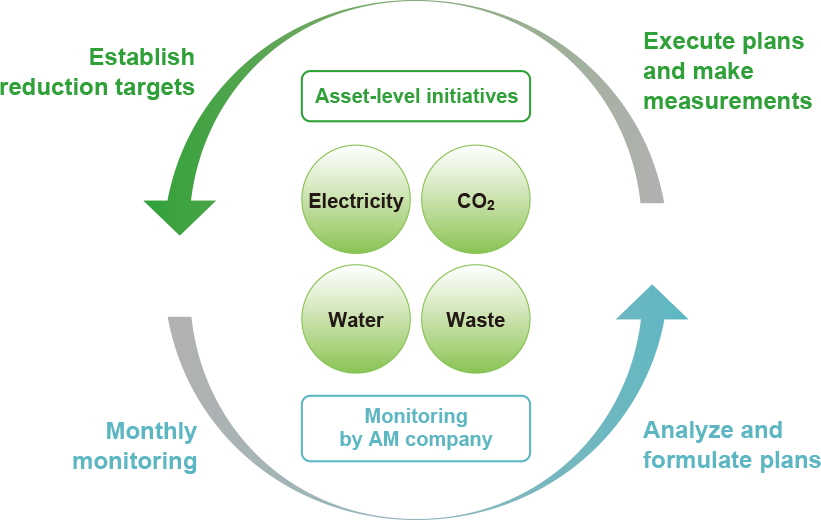
Contributions to the Environment through Real Estate Investment Management
Incorporating ESG Criteria for Property Acquisition
JRE has newly added the following factors to the assessment criteria (such as location and building specifications) it applies when acquiring properties.
ESG criteria to be incorporated
- Green building certifications
- Environmental performance including CO2 emissions
In establishing the abovementioned framework, JRE has obtained a second-party opinion from CSR Design Green Investment Advisory, Co., Ltd.
Please click here for more information for ESG criteria.

Environmental risk assessment at the time of acquisition
When acquiring real estate properties, JRE conducts on-site inspections and also investigates on soil contamination and toxic substances such as asbestos and PCBs by obtaining real estate appraisal reports and engineering reports in addition to receiving related disclosure materials from the sellers.
Environmental considerations in urban redevelopment project
Our sponsor, Mitsubishi Estate Co., Ltd. focuses proactively on environmental creation development through using natural energy and adopting energy-saving technologies. JRE, in cooperation with Mitsubishi Estate group, promotes sustainable urban development. Mitsubishi Estate Co., Ltd. is environmentally conscious, ensuring compliance with soil contamination and other environmental laws and regulations based on the “Mitsubishi Estate Group 2030 Goals for SDGs”.
Brownfield Redevelopment GRAND FRONT OSAKA
JRE acquired GRAND FRONT OSAKA (North Building) and GRAND FRONT OSAKA (Umekita Plaza and South Building) in October 2021, ensuring that countermeasures have been implemented against the brownfield land (former yard site) where groundwater and soil contamination has been confirmed.
The north district of the Osaka Station in which GRAND FRONT OSAKA is situated is the largest terminal in western Japan where seven stations and 12 railway lines converge. The property is directly connected to JR Osaka Station via a pedestrian deck and enjoys close proximity to Umeda Station on the Hankyu and Hanshin lines as well as various subway lines, making transportation extremely convenient.
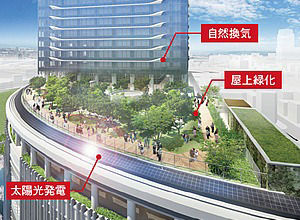
In terms of the environment, the property has a high standard of safety due to its excellent earthquake resistance from adoption of the latest damping structure. The property also forms a network of water and greenery in unison with the several blocks with greening, water features, etc. on rooftops and on the ground, realizing a harmonious environment as a whole.
Moreover, the property employed highly effective low‐CO2 technologies such as natural ventilation, high‐efficiency heat source systems, and solar power generators as well as establishing a network of Building Energy Management Systems (BEMS) of each of its buildings which centralizes control of energy consumption as an entire property. As initiatives for the entire development area, an organization called Town Management Organization (TMO) is set up and it develops city‐wide CO2 reduction management in a bid to realize a decarbonized society. As such, the property has been selected by the Ministry of Land, Infrastructure, Transport and Tourism as “Leading Low‐CO2 Model Business for Residences and Buildings”, serving as an “environmental showcase leading the realization of a sustainable society.”
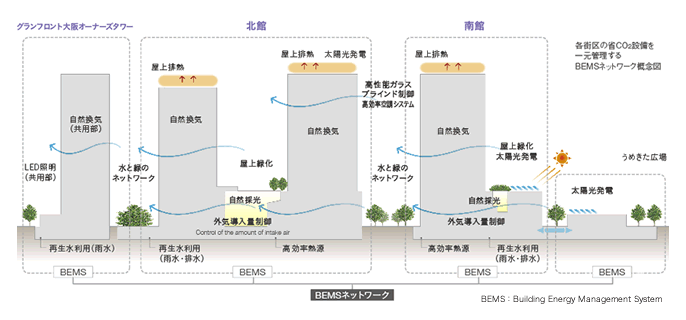
Consideration to urban greenery and biodiversity
JRE’s sustainability policy stipulates that it will contribute to conserving biodiversity and ecosystem. JRE gives consideration to biodiversity in the operation of buildings by endeavoring to conserve and improve the ecosystem on property premises and adjacent urban green areas and natural areas.
Note that while JRE does not invest in new development projects, the sponsor Mitsubishi Estate Co., Ltd. pursues sustainable land use using certification systems such as Association for Business Innovation in Harmony with Nature and Community (ABINC) certification and SITES certification at the time of development.
For details on the efforts of Mitsubishi Estate Co., Ltd., please click here.
Otemachi Park Building Biodiversity Preservation Initiatives
At Otemachi Park Building, located in the vicinity of the Imperial Palace, we have taken biodiversity into consideration, creating homes for a variety of flora and fauna by including a variety of trees and bushes, birdhouses, porous stone walls and waterscapes into the design. Under the leadership of our sponsor, Mitsubishi Estate Co., Ltd., we conduct monitoring of the living creatures in the area both as part of our cleaning and plant maintenance duties, and as an activity that the community can participate in as efforts to visualize the biodiversity network centered on the Imperial Palace and to collect and disseminate information aimed at high-quality green space management and greater environmental awareness.
In recognition of the efforts to conserve biodiversity in these spaces, the building has been certified by the Organization for Landscape and Urban Green Infrastructure under the Social and Environmental Green Evaluation System (SEGES) for creating green spaces, issued. Furthermore, it has acquired ABINC certification in the urban/SC category, issued by the Association for Business Innovation in Harmony with Nature and Community (ABINC).
In fiscal 2023, Otemachi Park Building’s Hotoria Plaza was certified as an Other Effective area-based Conservation Measures (OECM) site.
For details, please click here.
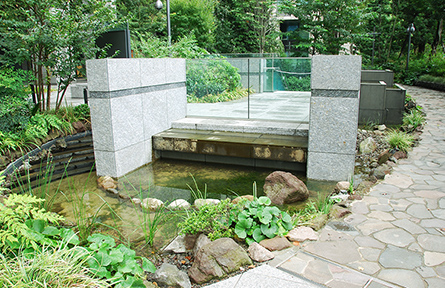
Hotoria Square

Waterscape that serves as home to various creatures
Investment in retrofit that contributes to resource productivity, higher efficiency, and lower environmental impact
JRE steadily implements the renewal plans made for the facilities in our properties in order to reduce the environmental impact of the buildings.
* Please view the table below while scrolling horizontally.
| Work details | Targeted building | Period | Energy use reduction effect | CO2 emissions reduction effect | Remarks | |
|---|---|---|---|---|---|---|
| Upgrading to LED lighting |
NHK Hiroshima Broadcasting Center Building |
2016 - 2017 | ▲189.9MWh / year | ▲32% | ▲136.5 tCO2 / year | Estimation based on the specifications |
| Upgrading to LED lighting |
Kanazawa Park Building |
2017 - 2019 | ▲969.8 MWh / year | ▲28% | ▲587.4 tCO2 / year | Estimation based on the specifications |
| Upgrading the air-conditioning system |
JRE Nishi-Shinjuku Terrace | 2016 - 2018 | ▲173.8 MWh / year | ▲22% | ▲63.7 tCO2 / year | Estimation based on the specifications |
Refurbishments of JRE Shiba 2chome Daimon Building
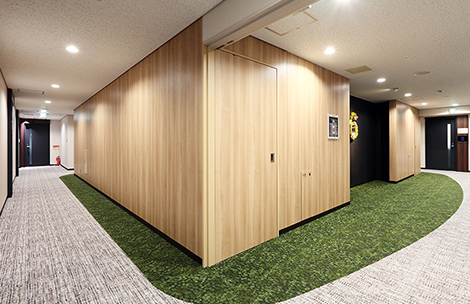
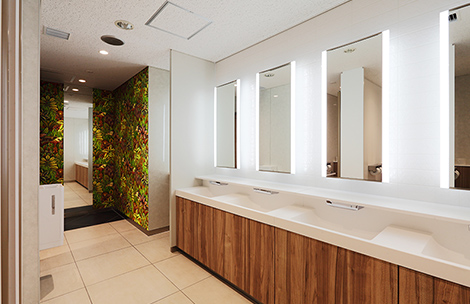
Proactive Introduction of Renewable Energy
Accelerated Use of Electricity Made from Renewable Electricity (RE100 Compatible)
JRE accelerates the use of electricity made from renewable energy recognized by RE100* ("renewable electricity"). As of the end of September 2024, JRE has completed the switch to renewable electricity at its properties of 100% operational control. JRE proactively introduces renewable electricity into the buildings other than 100% operational control and further accelerates the reduction of CO2 emissions.
RE100 is the global corporate renewable energy initiative bringing together hundreds of large and ambitious businesses committed to 100% renewable electricity.
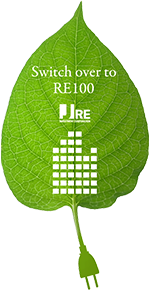

JRE’s Switch to Renewable Electricity (Outline)

Utilization of Onsite Renewable Energy
JRE promotes the reduction of CO2 emissions through the utilization of renewable energy in solar generation at some of the office buildings owned by JRE such as Otemachi Park Building, the ARGYLE aoyama, Shinjuku Front Tower, Toyosu Foresia, Toyosu Front, GRAND FRONT OSAKA (North Building) and GRAND FRONT OSAKA (Umekita Plaza and South Building).
Otemachi Park Building
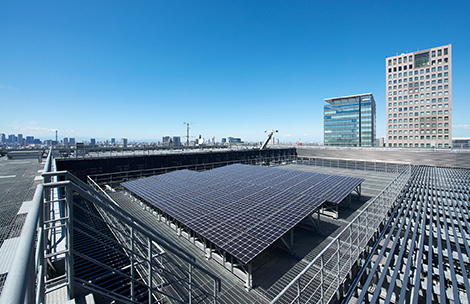

Reuse and Recycle of Water
Some of the buildings owned by JRE are equipped with facilities for reusing rainwater and greywater, as JRE endeavors to reduce the consumption of tap water.
Environmental contribution in collaboration with tenants
Aiming to make environmental contributions by collaborating with tenants, JRE has been gradually introducing Green Leases in terms of both operational improvement and efficiency retrofits.
Moreover, JRE is conducting diverse sustainability initiatives together with our tenants.
Introduction of Green Leases
JRE works to reduce environmental impact in cooperation with tenants by promoting the incorporation of green lease clauses in leasing contracts. Green lease clauses incentivize tenants to work on improving environmental performance and to share data on the consumption of energy, water, and other resources, reduce the amount of waste generated in renovations, and use energy-efficient and environment-friendly equipment and materials.
We also promote green refurbishments that utilize green leases that contains a cost recovery clause. When carrying out green refurbishments, both the building owner and its tenants reap the benefits of reduced utility and other bills to realize a win-win relationship. For example, the owner receives a portion of the savings made on electricity bills through green refurbishments back as green lease payments for a certain period by incorporating a cost-recovery clause, thereby ensuring a fair distribution of the economic benefits of such refurbishments.
<Kanazawa Park Building: Example of Installing LEDs Using a Green Lease Scheme>
At the Kanazawa Park Building, the owner installed LED lighting at its own expense in tenant areas. The owner receives a portion of the savings made on electricity bills thanks to the installation as green lease payments for a certain period, thereby ensuring a fair distribution of the economic benefits of such refurbishments. Even if tenants make green lease payments, these can be more than offset through reductions in utility bills. Accordingly, both tenants and the owner enjoy economic benefits. In addition, we pay an incentive fee to the PM that acts as the contact point for negotiations with tenants, provides explanations on the scheme, and collects green lease fees. In these ways, we have established a win-win system for all three parties: tenants, the owner, and the PM company. With the owner recovering its investment and enhancing the value of its real estate, tenants reducing their electricity bills and improving their work environment, and the management company receiving fees, the installation of LED lighting at Kanazawa Park Building serves as an example of how to establish win-win relationships for all parties while enhancing property environmental performance through CO2 emissions reductions.

Kanazawa Park Building
Other Examples
- Distribution of sustainability guide
For details on sustainability guide, please click here. - Holding Global Warming Prevention Committee with tenants
- Introduction of an online system that enables tenants to check their energy use
- Participation in the energy conservation month campaign and energy efficiency promotion on other occasions
Collaboration with Suppliers
Green Procurement Policy
JRE-AM which is JRE’s asset management company, has set the Green Procurement Policy as one of the policies to implement the specific items upheld in the Sustainability Policy. The Green Procurement Policy provides guidelines on the selection of products to be procured by JRE-AM as well as on the selection and evaluation of suppliers. JRE-AM has been promoting sustainability measures across its supply chain based on this Policy.
PM company selection criteria and evaluation measures
JRE has established selection criteria for property management (PM) companies to which it commissions the management of properties, and evaluates all of the PM companies once a year, in principle. In addition to the companies’ building management and maintenance abilities, JRE evaluates the PM companies by their environmental friendliness in terms of operations, occupational health and safety measures for their employees, and understanding of and cooperation with the Sustainability Policy set by JRE-AM. Moreover, JRE requests the PM companies to make proposals to help JRE reduce environmental impacts, such as energy efficiency measures in buildings. In this way, JRE makes environmental improvement efforts in cooperation with the PM companies.
Other measures
JRE makes contracts with professional firms to conduct energy assessment of a selection of our properties, and utilizes the results to understand the current level of their energy performance and to formulate improvement plans for the future.


